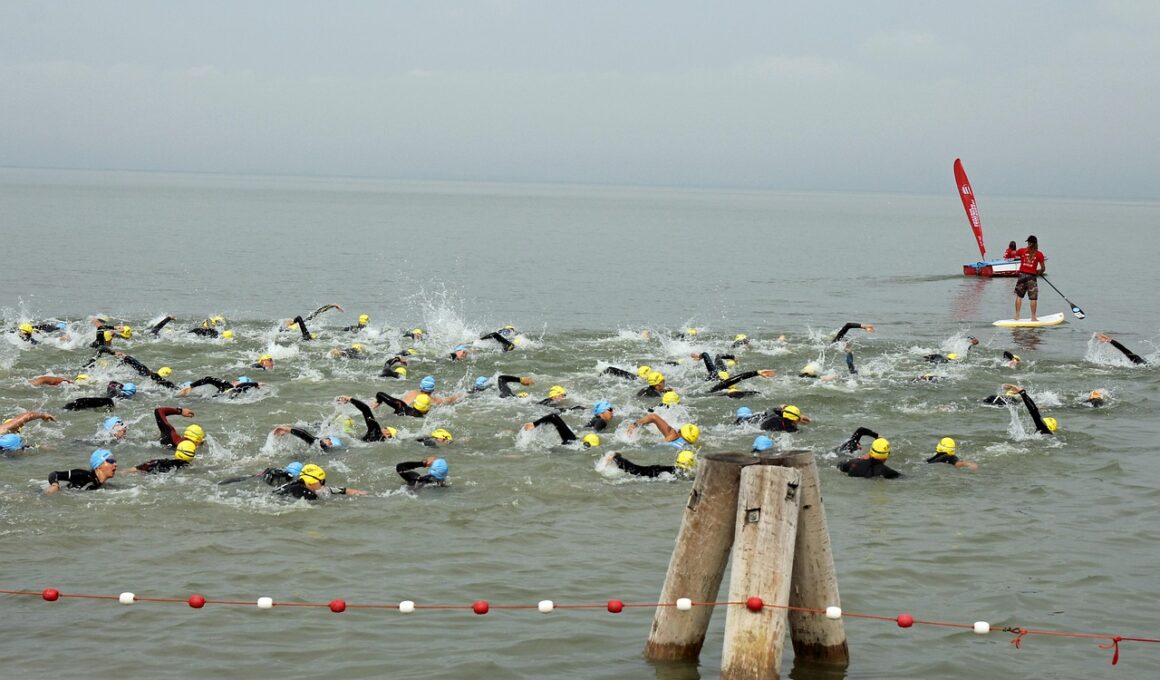Swimming with a Wet Suit: Benefits and Tips
Triathlon swimming can present unique challenges, but one essential tool that athletes utilize is the wet suit. Wet suits are designed to provide several advantages for swimmers, primarily in cold water. The insulation offered by these suits keeps body temperature regulated, allowing swimmers to focus on performance rather than battling the cold. Furthermore, the buoyancy provided by the wet suit enables swimmers to maintain a more streamlined position in the water. This buoyancy reduces drag, which can enhance speed and efficiency during swims. Finally, wet suits are made from materials that can help reduce the impact of choppy conditions, leading to a more controlled experience. For those considering a wet suit, it’s important to find a proper fit that allows for flexibility and comfort in movement. Not only does this ensure optimal performance, but it also prevents discomfort that could ultimately distract from the swim. Overall, investing in a quality wet suit is a decision every triathlete should consider. By understanding its benefits, athletes can leverage this gear to enhance their overall swimming experience during competitions.
When preparing for a triathlon, it’s essential to practice swimming with a wet suit prior to race day. Getting accustomed to the wet suit can significantly influence an athlete’s performance. During practice, swimmers should focus on techniques that prioritize buoyancy and reduce drag. Practicing in various water conditions, including currents and waves, can help swimmers adapt to the challenges of actual race environments. It’s crucial to perfect stroke mechanics while wearing the suit to avoid feeling restricted. Incorporating varied drills such as sprints can also build confidence and comfort. Additionally, swimmers should monitor their breathing, ensuring they remain calm and collected. Familiarity with the wet suit allows athletes to feel more secure in the water, knowing how it interacts with their body movements. It’s a wise idea to include some interval training wearing the wet suit to simulate race conditions. Moreover, consider experimenting with different styles of wet suits, as some may work better for individual swimming styles and body types compared to others. Ultimately, the more time spent practicing with a wet suit, the more comfortable a swimmer will be during the actual event.
Choosing the Right Wet Suit
Selecting the appropriate wet suit is a critical consideration for triathletes. The variety of brands and styles available can be daunting. Ultimately, understanding the fit is paramount. A properly fitted wet suit should feel snug but not overly restrictive. Swimmers can use various brands’ sizing charts as references to find their optimal fit. It’s beneficial to try on multiple wet suits to compare comfort and flexibility. Key features to evaluate include neoprene thickness and cut style, as these will impact buoyancy and movement. Shorter leg suits may offer less coverage but may enhance mobility in warmer waters. Swimmers should also consider comfort areas such as the neck and underarm regions, where irritation commonly occurs. Additionally, make sure to investigate seals and zippers, ensuring they function effectively. Most importantly, the wet suit should allow for a full range of motion without compromising insulation. Don’t forget to read reviews and gather feedback from other athletes to find out how different suits perform in real situations. In a crowded market, finding a quality wet suit tailored to individual needs can greatly enhance triathlon swimming experience.
Transitioning from swimming to cycling in a triathlon can be tricky, especially when wearing a wet suit. Planning for this transition can save valuable seconds and contribute to a smoother race experience. One effective strategy is to practice wet suit removal during training sessions. Familiarizing oneself with the unzipping and pulling off of the wet suit will reduce struggle during actual transitions. It’s also helpful to lay out transition gear in a systematic manner, ensuring efficient access between disciplines. Athletes should plan whether they want to remove their wet suits fully or partially, depending on weather conditions and personal preference. Moreover, practicing running and cycling with a wet suit on during training can increase comfort levels. Specific techniques, such as rolling the suit down to the waist while running or cycling, can further facilitate a quicker transition. Keep in mind that every second counts in a triathlon, and efficient movement can make a significant difference in overall time. By fully preparing and practicing transition techniques, athletes can mitigate the challenges presented by wet suits, ultimately contributing to a smoother and faster race.
Maintenance of Your Wet Suit
Proper maintenance of a wet suit is vital for ensuring longevity and performance. After each swim, it’s crucial to rinse the wet suit in fresh water to remove chlorine or salt, which can degrade materials over time. After rinsing, always hang the suit to dry in a shaded area to avoid direct sunlight. Heat exposure can lead to warping and material damage. Store the wet suit in a cool, dry place, ideally hung rather than folded to prevent creases. Employing mild soap can help remove stubborn contaminants or odors, but be cautious not to use harsh chemicals that can damage the neoprene. Additionally, inspect the suit regularly, checking for any tears or damage to seams and zippers. Small punctures can often be repaired with specific wet suit repair kits. Moreover, when transporting your wet suit, ensure it is protected from sharp objects or heavy weight that may cause tears. By adhering to these guidelines, triathletes can extend the life of their wet suits while maintaining optimal performance during races.
Navigating a swim during a triathlon with a wet suit may feel different for first-time triathletes. Water entry techniques are critical for maintaining speed and minimizing anxiety. Proper techniques include allowing waves or water to push the suit in instead of pulling. Practicing effective water entry maneuvers can help athletes become comfortable before the race. Athletes can also focus on proper body positioning to enhance comfort and efficiency. Keeping the head low during strokes helps maintain a streamlined position, reducing drag in the water. Core strength can assist in stabilizing the body, allowing for a steady, strong swim. Another useful technique involves performing bilateral breathing. This promotes balance in the water while allowing the swimmer to gauge surrounding conditions effectively. It’s important to remain calm and confident while swimming, as panic can lead to decreased performance. Using specific visualizations of successful swim experiences can ease anxiety. Lastly, pacing should be consistent, as taking off too fast can lead to exhaustion and affect subsequent cycling. By mastering these techniques, each swimmer can improve their ability to effectively swim in a wet suit during competition.
Conclusion
In conclusion, swimming with a wet suit presents numerous advantages for triathletes, particularly in colder water conditions. Understanding how to select the right suit and practicing with it can lead to enhanced performance. The additional buoyancy from the wet suit can significantly improve speed in water while providing insulation from colder temperatures. Furthermore, practicing transitions ensures that each athlete can navigate between disciplines efficiently, minimizing lost time. Regular maintenance is essential for preserving the condition of the wet suit, contributing to its longevity and optimal performance. Additionally, mastering swimming techniques while wearing a wet suit leads to a seamless experience, even in challenging conditions. Relying on profession-specific strategies can help alleviate anxiety while increasing confidence during the swim leg of a triathlon. By prioritizing effective preparation and practice, athletes can maximize their potential in the water. Ultimately, embracing the use of a wet suit is an investment in enhanced performance and a smoother experience, ensuring that each swim contributes positively to overall success in triathlons. Remember, every small preparation leads to significant gains on race day.
To top it off, swimmers should remain flexible in their approach, adapting techniques as necessary to account for weather conditions or personal preference. Arm technique, body position, and kicking style may need slight adjustments with or without a wet suit. As race day approaches, stay committed to the training plans and incorporate any learned techniques. Proper hydration and nutrition are equally vital, as they ensure energy levels remain high throughout the event. By joining swimming groups or triathlon clubs, one can learn from shared experiences or tips from others who have already conquered similar races. Use these social networks to refine your strategy, benefiting from community advice along the way. Overall, your experience and confidence will gradually build over time as you embrace these valuable lessons. Each swimmer’s journey is unique, yet the common thread remains the focus on strategy, comfort, and practice. Staying informed about gear advancements and attending triathlon workshops can provide insightful tips that enhance competitive advantage. With dedication and guidance, mastering the use of a wet suit will contribute to your overall swimming performance in triathlons.


